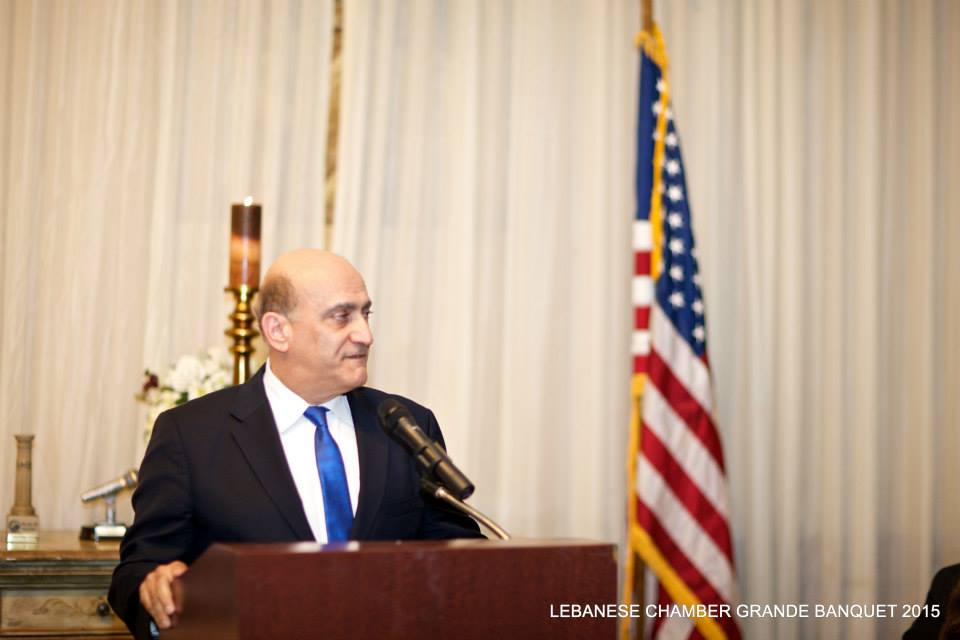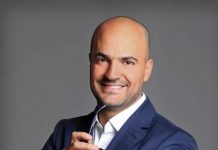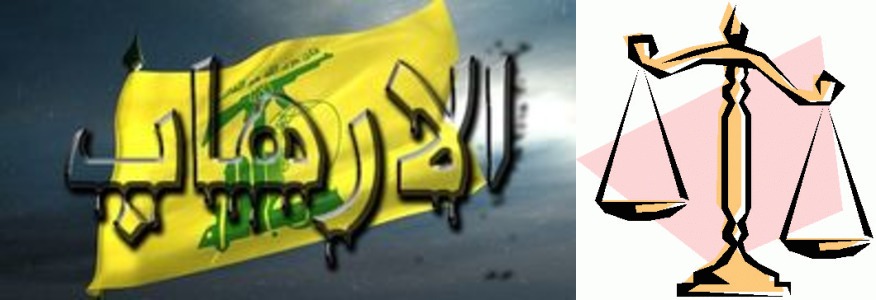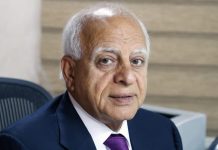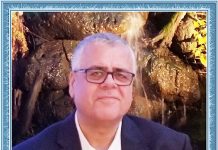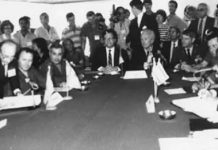Interview with Dr. Taufic Hindi from “Family Security Matters” Site Focusing on Dr. Walid Phares’s Political and Patriotic Activities before immigrating to the USA in 1990.
Attacked by Radical Media: Adviser to Presidential Candidates Exonerated
Interview with Dr. Toufic Hindi Conducted by Dorothy Logan/April 20/16
Dr. Toufic Hindi is a Lebanese politician, a university professor, and a commentator. He was the political advisor to the Commander of the Lebanese Forces, Dr. Samir Geagea, from 1986 to 1994 (when Dr. Geagea was jailed by the pro-Syrian regime in Beirut). Hindi played a central role in the LF and in the opposition to the Syrian occupation of Lebanon between 1994 and 2005. In that period, he was arrested and jailed by the pro-Syrian regime of Lebanon before he was released by the courts. Over the past 11 years, Dr. Hindi has been active in Lebanon’s political arena and a national commentator on local and regional politics. We are conducting this interview with him to examine, in particular, specific parts of the history of the Lebanese Forces during the 1980s.
Question: Dr. Hindi, you have been the political advisor to the Commander of the Lebanese Forces, Dr. Samir Geagea, between 1986 and 1994. These were critical years, where significant areas of Lebanon (such as East Beirut and Mount Lebanon) were defended by this coalition. Might you explain to our readers who and what the Lebanese Forces were during that period-perhaps by providing a quick history lesson?
Dr. Hindi: Unlike what you often read in the international media, the Lebanese Forces were not a militia per se; they emanated initially from a coalition of political parties, most of whom predated the war of Lebanon in 1975, and created a unified force to defend the Lebanese Republic by defending the Christian areas of Lebanon when they came under attack by Palestinian armed groups and later by the Syrian regime army and their proxies. The political parties early on, between 1975 and 1980, had each formed their own militias to defend the “free areas” of Lebanon-along with the Lebanese Army. But in July 1980, the militias were replaced with a regular military corps, named “Lebanese Forces,” and supervised by a political coalition named “Lebanese Front.” As Americans, you can think of it as similar to the “Continental American Army” facing the British. In Lebanon, the “continentals” were the Lebanese Forces. So it is correct that so-called militias were formed by the main political parties in the Christian community in 1975, and these militias were disbanded and merged with a National Guard type of force in 1980. For the following decade, the LF were organized militarily but under a political structure representative of the political parties of the so called “free areas.” There were two political levels that oversaw this “National Guard.” One level was the representative council headed by the LF commanders, and the higher level was the Lebanese Front, which included the parties’ leaders, intellectuals, and prominent public personalities. The LF acted, practically, as a local government with departments dealing with education, social security, finances, defense, foreign affairs and diaspora. Technically, this was a de facto cabinet managing the “free areas” until the national government’s return to life. It was disbanded at the end of the war in 1990, and the political parties returned to normal political life.
Question: The Lebanese Forces are often accused of having committed massacres and violence against civilians throughout the war. Was that indeed true of the war?
Dr. Hindi: First, one has to understand during which part of the war who did what. The LF was not a single body from 1975 to 1990. That would be like saying that the US Administration in 2016 committed violations in Abu Ghraib in 2004 or the White House in 2012 was responsible for what some rogue soldiers did in Vietnam in 1968. As far as I know, there were never institutional decisions by the leadership of the LF to take a collective violent action against collectivities of civilians anywhere in Lebanon-at least, not since it was formed as unified body in July 1980. Like in all wars and even in any country, there were and are thugs who commit individual crimes. On the other hand, the Syrian Army and the pro Assad factions of the PLO committed many massacres ordered by the leadership of the institutions while there were certainly exactions by members of the LF as there were by members of the US, French or other Western armed forces. So to be very precise, while there were acts of violence during the war, including within the free areas, I have never seen nor heard nor learned about orders given to the hierarchy by the command to perpetrate any violence against a whole community because of religion or ethnicity between 1980 and 1990.
Question: But many among its foes, including Islamists, Jihadists and pro Iranians, accuse the Lebanese Forces of being responsible for the so-called Sabra and Shatila massacres in September 1982. Was that not the case?
Dr. Hindi: No, that was not the case. It was established-by Lebanese authorities-that rogue elements “wearing the uniforms of Lebanese Forces” perpetrated collective killings of civilians on September 16 to 18 of 1982. The armed elements belonged to a security unit whose commander, though part of the LF hierarchy, was actually in contact with the Syrian regime. There is a book about that written by one of that commander’s assistants, Robert Hatem. These rogue elements acted on their own and for years caused more moral and political harm to the LF than any other faction. What is essential is that, according to the minutes of the LF Council of Command of September 1982, there was no official meeting of the LF command with the political parties represented that gave such an order as was the case when the pro-Syrian Baathist Saika organization planned the mass killing of civilians in Damour in 1975 or when the Syrian command ordered the elimination of many citizens in the Bekaa in 1978. The Sabra and Shatila shootings were disgusting, but they were the work of Christian rogue elements in a late response to the massacres by Saika forces of Christian towns in the years before, including in Damour and Aishiye. Some believe the Sabra and Shatila shootings were most likely manipulated by the Hafez Assad intelligence services, via their penetration within the LF, to crumble the Israeli-Lebanese talks and were done immediately after President-Elect Bashir Gemayel was assassinated by a pro-Assad terror group on September 14, 1982. Had Gemayel been alive, there would not have been those incidents in Sabra and Shatila. These and other Palestinian camps were taken by the Israelis weeks earlier, and the LF were circulating in those areas without committing similar shootings. In fact, Bashir Gemayel addressed his officers a few weeks earlier and specifically told them not to hurt anyone after the Israelis invaded Lebanon. It is an important speech and can be found in Lebanon’s press archives. At that time, nothing happened. It was only after Bashir was killed and the LF chain of command was adrift that these incidents occurred. The Israeli-LF relations in effect started to collapse after that episode. But since then, the propaganda machine of the adversaries of the Lebanese Christians kept using the Sabra-Shatila incidents, as an isolated bloody incident-with no explanation-in order to harm the image of the community and of its public figures in the following years and decades, even though this understanding was completely baseless.
Question: Recently, during the current U.S. Presidential campaign, there have been hit articles initiated by an Islamist group and later by far left and pro Iranian bloggers circulating across the internet, leading to controversy over one of Mr. Trump’s foreign policy advisors, Dr. Walid Phares, who also happened to be an advisor to Presidential candidate Mitt Romney in 2011-2012. Some of these criticisms allege that before his emigration to the United States in the 1990s, Phares had links to or was a member of the Lebanese Forces’ military, and thus some went as far as implying that he was somehow tied to violence against civilians perpetrated by the group because of his ties to the Lebanese Forces. Does that make sense to you?
Dr. Hindi: First of all, as a Lebanese citizen, I don’t permit myself to interfere in domestic American politics, but it happens that I got to know Dr. Phares well, and my answer to your question concerning him is: No it doesn’t make any sense at all. Those imputations are false, and the people who are making them either don’t have any knowledge about Lebanon’s history and politics or they are making them with the goal of smearing a public figure in US politics. Here is why: Walid Phares was a young lawyer, an author, and a publisher between 1979 and 1986. Prior to that, he was a student in law and political sciences at St. Joseph University. His public career started very early at the age of 23 in 1979 when he published his first book in Arabic Pluralism in Lebanon while he was still a student, a book in which he portrayed the country as being multiethnic and argued the best form of solution to the internal conflict was a mutual recognition among its communities and a federal system. He then published a series of books and essays focusing on pluralism and on the necessity of democratization within the free areas where he lived. In 1982, he launched a weekly dedicated to minorities in the Middle East, Sawt el Mashreq (Voice of the Orient). The publication had versions in French and English. He was opposed to the Syrian occupation of Lebanon. During this period he practiced law as a defense attorney and offered lectures to communities and institutions, including to the Lebanese Forces, led then by Bashir Gemayel and his successors, from 1980 to 1986. His published material is very large and available in the archives of the Lebanese press, which also covered his lectures and interviews in Arabic and French.
Dr. Walid Phares (1982)
In 1982 and 1983, Phares was a critic of the policies of the Government and was calling for a political opposition in the Christian areas. In June 1983, he was pressured to not pursue this opposition. Walid widened his publishing records and talks regardless. He even formed a small social democratic party, a workers union, a student group and a minorities committee. He was acting as a center left young politician opposing Syrian occupation and calling for a federal Lebanon, but within the limits of who controlled the Christian areas, the Lebanese Forces. We met in 1984 and had a long series of discussions pertaining to the situation and the future of the country. It was only in 1986 that Phares was invited to join the political representative council overseeing the Lebanese Forces as a representative of his own party, the PSDC. The LF then was led by Dr. Samir Geagea. Phares served for two years, resigned and concentrated on his own party and civil society groups until he emigrated in 1990.
Question: He had been labeled as a Phalangist. Is that accurate?
Dr. Hindi: Walid Phares has never been member of the Kataeb Party (Phalanges) as far as I know. In the Arab world at that time, many would call someone “Phalangist” just because he is a Lebanese Christian who opposed the PLO or the Syrian occupation. Phares and his brother had launched their own small political group which was on the one hand patriotic in terms of Lebanese identity, and on the other hand socially democratic. His party was often suppressed by the dominant parties and militias, but as a member of the political council he had to have cordial relations with all political parties, including the Kataeb. To understand this, you need to realize that the Lebanese Front/Lebanese Forces were a sort of a local government with many political parties represented in their political structures. For example, the LF consisted of the Kataeb, the Liberal Party which was in the center, Tanzim, Guardians of the Cedars, Syriac League-and Phares’ Social Democratic group, the only one left of center. The LF were not a militia per se in the sense understood in the United States or the West. It was more of a local government overseeing the defense of the free areas, which were mostly Christian.
Question: Mother Jones claims Phares was the advisor of Samir Geagea, the head of the Lebanese Forces. Was he his advisor?
Dr. Hindi: No, he was not Geagea’s advisor, for the simple reason that I myself was the one and only political advisor in title of Dr. Geagea from 1986 until 1994. Walid was appointed as director of the Department of International Relations from 1986 to 1987 before he was appointed to another department for the émigrés in 1987. He used to meet diplomats or visit Lebanese communities around the world. He quit his positions in 1988 to consecrate his time to his social democratic party and the workers union. During these years Phares kept offering lectures and was elected as Secretary General of the Maronite Diaspora organization and attended conferences in several countries. I don’t know where Mother Jones got its information, but both I and Walid Phares were in the news and our titles were very clear. A simple research in the press archives would clearly outline our activities to anyone looking. It was all public and common knowledge. I did not, however, see any reference to the Lebanese press between 1979 and 1990 in Mother Jones’ two articles about Walid.
Question: Some blogs, though questionable, claim Walid Phares was a member of the group called “Guardians of the Cedars” and go on to ascribe extreme slogans used by this group to Phares. Was he a member of this faction?
Dr. Hindi: Of course not. I really don’t understand who is circulating these false facts. Dr. Phares was not a member of the Hurras El Arz, or “Guardians of the Cedars,” a political party led by Mr. Etienne Sacr, who is still alive. This party was represented in the council but had nothing to do with Phares’ Social Democratic party. Moreover, the Lebanese-Phoenician strictly nationalistic ideology of the “Guardians of the Cedars” was the antithesis of the pluralistic ideology of Walid. Again, it seems to me that those who are circulating this false information are abusing the fact that the public in the United States has no way to check any of this very basic information available aplenty in Lebanon’s archives.
Question: Some blogs and extremist lobby groups have connected Phares to very troubling terms, such as “war crimes” and “Sabra and Shatila” links. We know they are smearing him for political reasons, but how can such accusations even stand? Can he sue them?
Answer: These seem to me as hallucinations, and of course he can sue them for defamation. First of all, Walid was not even in the military. He was a human rights lawyer and a political public figure. How anyone labels him as violent is beyond me. As much as I know, in September 1982 during the days when Sabra and Shatila shootings took place, he was practicing as a young defense lawyer and a publisher. In the days and weeks after, he and his law offices got many Palestinians and other citizens out of jail and defended them. Besides, if you read his book about pluralism, he dedicates it to, among others, the Muslim and Arab peoples. And in his booklet “Democratic Dialogue,” he engages in intellectual debates with all contemporaries, including Muslim Arab nationalists and Lebanese Christian nationalists. Phares had zero connection to military and violence. He only joined the LF political council as his party representative four years later, in 1986, while the mentioned events were half a decade before. It seems to me that his critics are bothered by his writings and speeches and have no way to counter except by these misrepresentations.
But the larger picture is more important. The accusation against the Lebanese Forces as being responsible for the Sabra and Shatila massacres is false. These terrible incidents, part of the larger war in Lebanon, were perpetrated by rogue elements. The other factions did worse. The command of the LF during September 1982 should have been questioned about the circumstances of these incidents because the political command has never been named by anyone or any court as directly responsible. So why would the next few “cabinets” of the LF, particularly that in 1986, even be hinted at as responsible? It would be as if Secretary Clinton was made responsible for rogue US soldiers’ shootings in Vietnam! So the entire notion of responsibility of the LF-even as a local government-does not stand to begin with.
Question: What was the relationship between the US and the LF for all these years? I mean, officially?
Dr. Hindi: Well, that’s the great question. Washington has partnered with the Lebanese Forces since at least 1981 as an ally against terrorism. Bashir Gemayel was received in the United States, and a US defense secretary visited the LF leader in Lebanon in 1982. The US engaged with the LF throughout the 1980s, and their diplomats were in touch with the LF under different leaderships in Beirut and successive administrations in Washington. They were partners until the end of the conflict in 1990. Furthermore, the LF had a representative office in Washington from the late 1970s and it was in touch with the State Department. The office existed for decades, until the early 1990s. The office worked with many US lawmakers from both parties for many years. Even after the war was over and the national defense organization was dismantled, the LF Party members and supporters in the US have been involved in support for members of Congress and remained very close to the Democratic and Republican administrations-and they continue this practice. The LF groups, associated entities and individuals helped in campaigns and fundraisers, including under both the Bush and Obama administrations. Government representatives at high level attend the meetings and celebrations held in Congress. In recent years, we’ve seen members of the Obama administration, the Clinton State Department, and the Republican leadership speaking at LF events. Would US government officials speak at their events if they were what the slanderers of Phares claim they are? So to describe it a “Christian militia tied to violence” is not only insulting, but it shows that the description is not an American one, and instead most probably one created by pro Iranian and pro Jihadist propaganda.
Question: Another related question is about Samir Geagea’s relations to the Palestinians. In the attacks against Professor Phares, pro-Iranian propaganda says Phares was an advisor to Geagea, a claim you just identified as false. But then they argue that Geagea was the head of the LF and in previous years the LF were at war with the Palestinians. They appear to be trying to make a long shot connection between Dr. Phares and enmity with the Palestinians. Does this theory even have wings, let alone fly?
Dr. Hindi: Another calumny and slander. Yes, the LF and the PLO, FPLP, Saika, and other factions were at war from 1976 till 1982: Two fighting camps. But after 1976, the main foe of the LF was the Syrian occupation army, not the Palestinian forces. In the late 1970s and just before 1982, the PLO was at war with the Syrian forces of Hafez Assad. The LF and the Palestinians of PLO did not engage much on the battlefield. More interestingly is the fact that under Samir Geagea, the LF and the PLO engaged in a dialogue and the Israelis actually accused Geagea of helping Arafat. Years later, the rapprochement between Geagea and the Palestinian Authority became public with Geagea and Mahmoud Abbas meeting openly. A more controversial episode was when LF Party lawmaker visited Gaza and met with Hamas few years ago. How on earth can this propaganda slam Phares in the US for having been in an organization headed by a politician who entertained at that time and is actually entertaining friendly relations with the Palestinians now and accuse Phares of being anti Palestinian?
Question: A woman by the name of Regina Sneifer, who allegedly said she served in the Lebanese Forces, told Adam Serwer of Mother Jones that Phares gave lectures to officers of the LF in which Phares said that Lebanon should be partitioned and the militia should become a “Christian army.”
This took place before I joined the LF. Most likely in 1980 or 1981 after Walid Phares had published his first book Pluralism in Lebanon when he had been offering lectures to the community and to many audiences. He was invited to give a series of lectures on the history of Lebanon and of the Christian community. Over the years, thousands of people listened to his lectures on the evolution of the Middle East and of Lebanon. He had dozens of articles and was interviewed by radio stations many times. All of what he lectured about was in his books. So, the fact that he lectured to LF officers was very normal in East Beirut. It is like a scholar lecturing at West Point or the War College in the US. Phares traveled and presented at conferences around the world. I don’t know what Ms. Sneifer has heard from him, but none of his ideas were hidden. It was all public. His central theme was that there are ethnic and religious minorities in the Middle East, including the Christians of Lebanon, the Copts, Druze, Assyrians, Nubians, and others who were under suppression and threat by extremists, and these minorities needed to be recognized. His vision was three decades prescient as we have seen what happened to these minorities in recent years at the hands of ISIS. He spoke about them and created, as I remember, an NGO federation in 1981 known as MECHRIC to raise their issues internationally. Last year I learned that Dr. Phares led these NGOs to the UN Security Council for that purpose, thirty five years later. I am not aware of what Ms. Sneifer has said or written.
Question: Another source cited by Serwer in the Mother Jones article of 2011 was an activist in Beirut by the name of Toni Nissi. He was a member of an NGO part of an international federation of NGOs existing under the name “Cedars Revolution.” Nissi claimed he was an associate of Phares and was quoted on the substance of the latter’s advising to Geagea and the content of his lectures in the LF. Was Nissi a major player in the LF or in the public debate?
Dr Hindi: Throughout the 1980s I never personally heard of him in any public debate or any written material, probably because he was very young then. Fifteen years later I learned that he was a member of an NGO in Beirut which was part of an international NGO advised by Dr. Phares. One could wonder why Serwer would call him an associate from the 1980s. He wasn’t then. But later on, according to press releases, we learned that Mr. Nissi was indeed an active part of an NGO backing the “Cedars Revolution” and UNSCR 1559. But that was as of 2005. From my point of view, neither Sneifer nor Nissi could be considered as valid sources on major events in the 1980s, events which were well covered by the press. The Mother Jones journalistic method needs to be more professional. If they wish to criticize Phares’ ideas, the sky is the limit. If they want to criticize his positions in the 1980s, the press archive is large. They haven’t cited any credible media sources in Lebanon.
Question: Assuming Nissi isn’t a serious source for the specific period of the 1980s, could his assertion still be valid? Was Phares an ideologue of the LF?
Dr. Hindi: Here again, the LF had an ideologue in charge of ideological education. His name is Antoine Najm, and he is still alive. He has written the official doctrine of the LF under Samir Geagea. It is documented, published and available. Walid Phares was a historian and political scientist. He lectured to the public and to all institutions in the area. He developed the ideological and political platform of his own party, the PSDC (Social Democratic Christian Party) and the booklet is available. Many in the LF have read Phares’ books and some subscribed to his historical analysis and his call for federation. That is all.
Question: Is it known and do you know why Phares left Lebanon in 1990? Is it because he opposed the Syrians and he felt insecure?
Answer: It is not a simple answer. Many of his colleagues who adopted his same positions stayed in Lebanon and many among them are politicians or businessmen today. However, some of them had to follow a different narrative in public policy. The Syrian occupation was heavy handed. Walid has never been in the military to fear repercussions. Is it ideology? Well, the actual ideologue of the LF stayed in Lebanon. My assessment is that Dr. Phares wanted to be in a very free country where he could continue to write and act without having to self-censor. Besides, he has decided to enter a new American life, with a wider intellectual scope than Lebanese politics. He emigrated fully.
Question: Had Mother Jones and the other attackers against Walid Phares done a better job by researching Lebanon’s media archives, would they have found information contrary to the picture they painted of Phares?
Dr. Hindi: Of course. He was a young public person in that part of Lebanon. From the year he published his first book in 1979 until the year he left in 1990, he left many intellectual and political traces behind him. He published many books, articles and essays. He lectured and taught at universities. He practiced as a lawyer and engaged in public policy. It seems to me that the lobbies smearing him in the US have a clear political agenda unrelated to his life in Lebanon, and instead related to those years spent in public service in the United States. Americans aren’t interested in how many books and articles Walid Phares published in his twenties in his motherland. They are interested in his many books and professional successes in his new homeland, America. I think that in order to stop him from becoming an influential public figure in the US, his political enemies have tried to build an imaginary history of Walid Phares in Lebanon. None of what they claimed is accurate. That’s why we know they haven’t done a professional job-of reading his books or his articles or inquiring of his real colleagues. All they had to do was watch his television appearances or quote his books. They didn’t. People in Lebanon would laugh at such US-based media who report like journalists from the third world. How ironic that those who criticize Phares in Lebanon do not use the same ridiculous material published by his critics in America. They go to his abundant public record and use what they disagree with. For example, Hezbollah and other radicals refer to his influence in the US or his views on Israel, Saudi Arabia and Iran. No one creates an imaginary story like his critics in America.
**Dorothy Logan is a program coordinator for the Catherine T. MacArthur School of Leadership at Palm Beach Atlantic University where she also teaches political science and cultural history.















